
Things we like
- Corolla Cross: Strong engine & drivetrain, good on fuel, good servicing deal, strong safety
- HR-V: Mature design in and out, clever interior, great on fuel
Not so much
- Corolla Cross: limited rear legroom, blanking buttons inside, some cheap materials
- HR-V: Missing some safety kit, e:HEV runs out of puff, only four seats
A Honda and Toyota battle should be a lop-sided one. Honda is tiny compared to its Japanese rival, without the megabucks to invest in new technology like hybrid and battery electric cars as well as filling niches with convincing machinery.
Yet Honda beat Toyota to the roomy compact SUV segment with the HR-V by an entire generation and even got its first battery electric vehicle out the door a year or two before the troubled bZ4X.
When it comes to hybrids, though Honda has a real battle on its hands. It has dabbled with the technology for a while, but nowhere near Toyota’s scale.
And so here we have the first hybrid HR-V and the Corolla Cross hybrid going head to head. As we already know, paper means nothing, it’s all about execution.

JUMP AHEAD
- How much are they, and what do you get?
- Interior comfort, space and storage
- What are they like to drive?
- How are they on fuel?
- How safe are they?
- Warranty and running costs
- VERDICT
- Specifications
How much are they, and what do you get?
Once you’ve got all the taxes and charges sorted out, these two are remarkably close to each other on price and specification.
The HR-V e:HEV is $47,000 drive-away while, in NSW at least, the Corolla Cross GXL Hybrid is $46,512 drive-away. Add a nicer colour to the Toyota and you’ll pay $47,105 drive-away for it. So that’s pretty close.
As you can see in the table below, it’s almost line-for-line identical, with little details like the Honda’s heated steering wheel and the Toyota’s larger media screen.
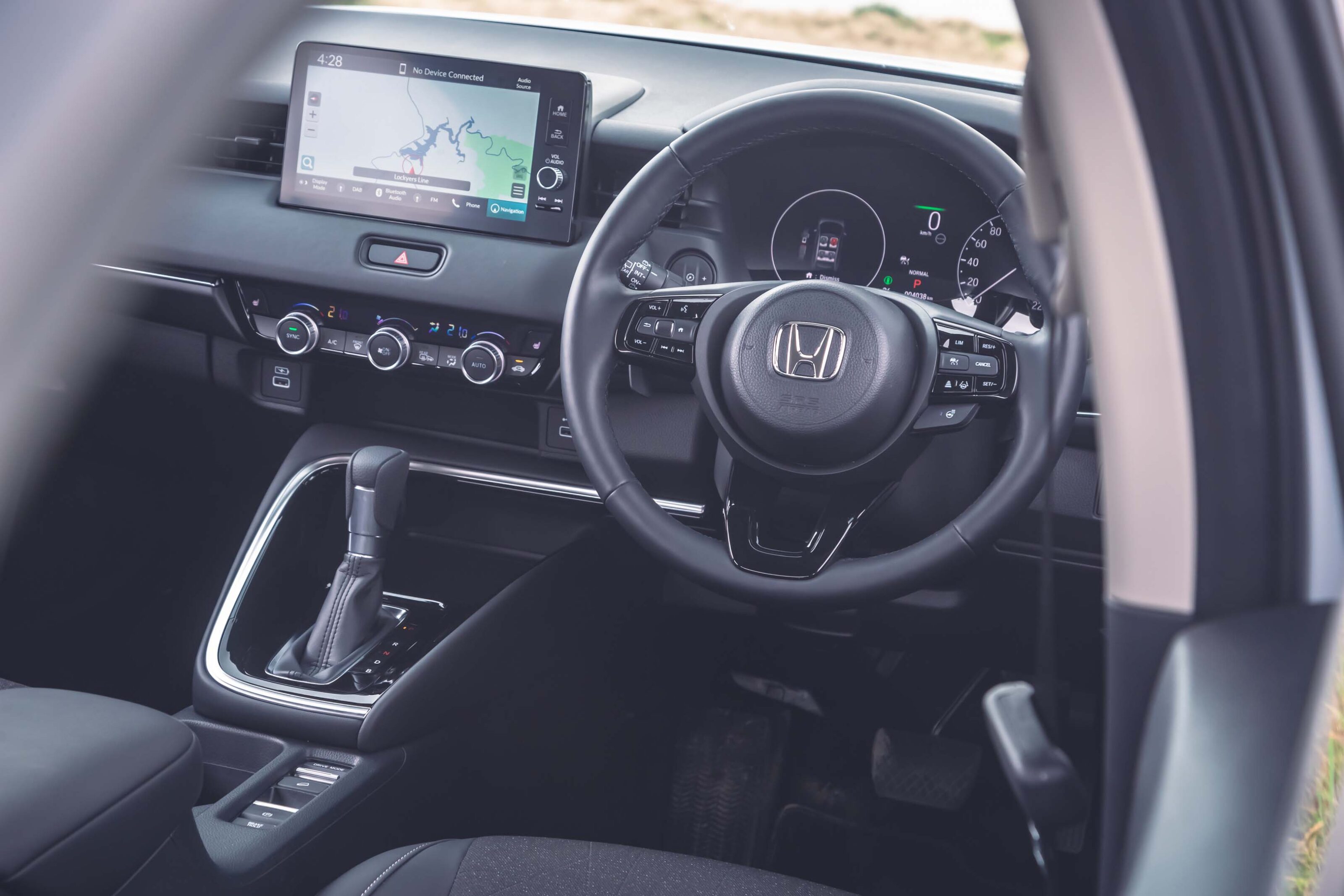
| Honda HR-V e:HEV | Toyota Corolla Cross Hybrid GXL |
|---|---|
| $47,000 driveaway | $42,250 + ORC |
| 18-inch alloy wheels | 17-inch alloy wheels |
| Six-speaker stereo | Six-speaker stereo |
| Front and rear parking sensors | Front and rear parking sensors |
| Reversing camera | Reversing camera |
| Keyless entry and start | Keyless entry and start |
| Dual-zone climate control | Dual-zone climate control |
| Heated leather steering wheel | Leather steering wheel |
| Automatic LED headlights with auto high beam | Automatic LED headlights |
| Power windows front and rear | Power windows front and rear |
| Adaptive cruise control | Adaptive cruise control |
| Fake leather interior | Fake leather interior |
| Digital dashboard | Part digital dashboard |
| Powered, heated and folding rear vision mirrors | Powered, heated and folding rear vision mirrors |
| Tyre repair kit | Tyre repair kit |
| 9.0-inch touchscreen | 10.5-inch touchscreen |
| Sat nav | Sat nav |
| Wireless Apple CarPlay | Wireless Apple CarPlay |
| Android Auto (wired) | Android Auto (wired) |
| Powered tailgate with walk-away function | Toyota Connected Services |
| Auto wipers | Digital DAB radio |
Honda’s 9.0-inch touchscreen is better than the old HR-V’s but is nothing to write home about. The hardware itself is fine but the basic tile interface along with options strung out along the upper and lower margins of the screen is not as intuitive as one might hope. Honda should do a Volvo, give up on bespoke software and submit itself to the genuine glories of Android Automotive.
Toyota probably should do the same but I can’t let the dramatic improvement in both hardware and software go unremarked. I have long been making increasingly hurtful fun of Toyota’s horrid media software found in cars that the company is trying to sell to young people.

This new system was instantly familiar to me as it presented very similarly to the new Lexus system in the NX, with the sat-nav serving as the home screen and a column of icons down the right-hand side popping out when needed (to select CarPlay, for example).
It’s nice enough to use, but the lack of a home screen kept making my brain hurt. No doubt familiarity will ease that effect or I’m just being stubborn in my old age.
Long story short, no more “drunk accountant on Alibaba buying five million units” jokes from me. It’s a heck of a lot better. The Corolla Cross also debuts Toyota’s Connected Services system of voice control and web search for restaurants and other facilities, as well as limited control over the car’s functions.

Interior comfort, space and storage
The new HR-V is a visibly smaller package than the Corolla Corolla, as the Toyota’s chunkier looks suggest its dimensions are bigger than they are.
Starting with boot space, if we’d put the previous HR-V in this blue, the Honda would win. However, this third-generation car has a smaller cargo area than before, the 2022 HR-V offering 304 litres of boot space (to the old car’s 437L), soundly beaten by the Corolla Cross’s 390-litre boot.
Both have a tyre repair kit, the Honda presumably to try and maximise boot space.
Seats down, the HR-V’s figure rises to 1274L. I’d like to tell you what the max capacity figure of the Cross is, but Toyota doesn’t offer one. I’d bet on it comfortably out-pacing the Honda by about 50 litres.
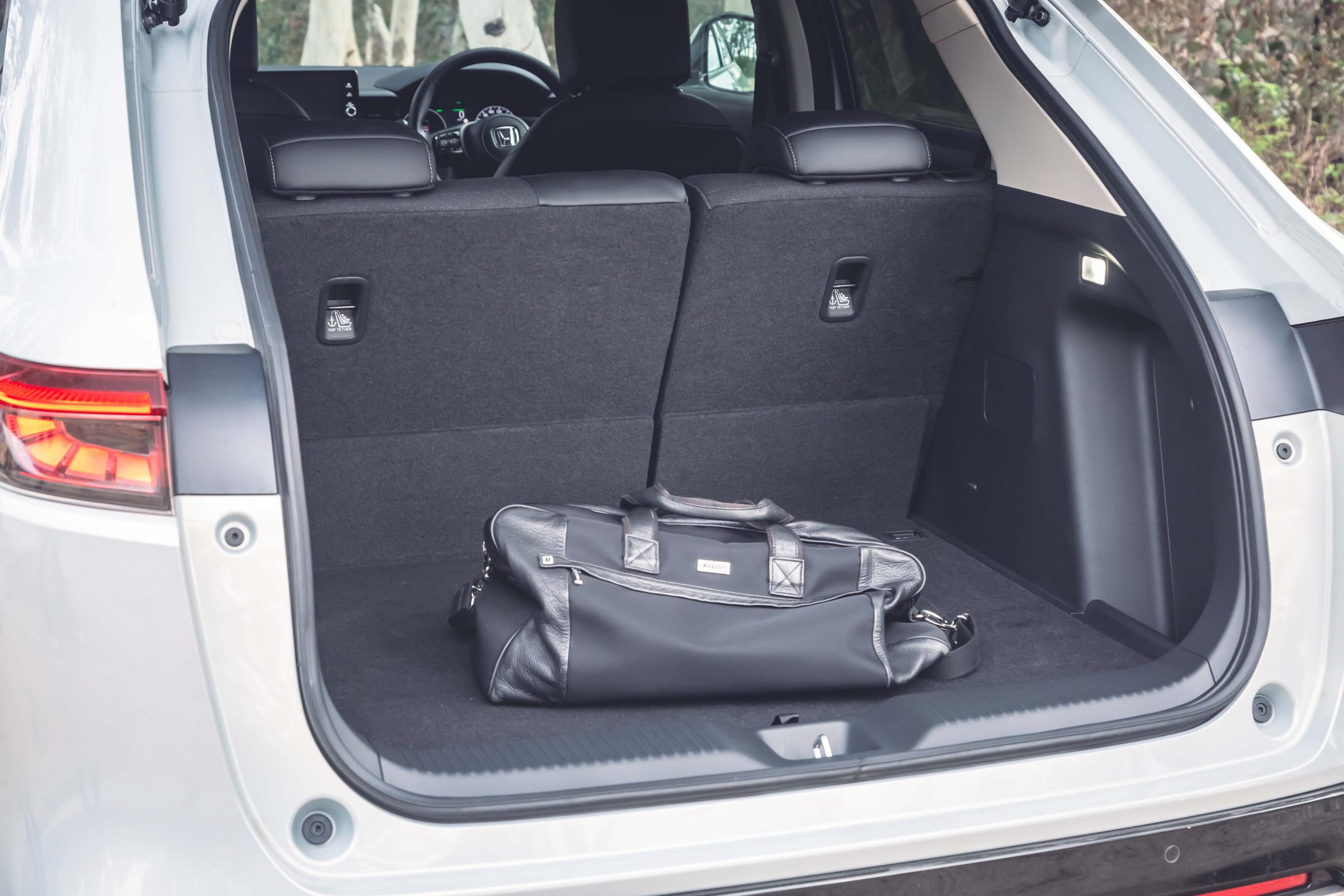
In the back seat, the Corolla takes a technical win by providing for three passengers, but two up the Honda is substantially better. There’s a lot more legroom in the HR-V and even the shape of the floor provides a nice little ramp for your feet. It’s airier, too, and the slim front seats intrude less.
The seats themselves are like individual buckets, with lots of lateral support whereas the Toyota’s is just a run-of-the-mill offering that is comfortable enough, but with surprisingly tight legroom. You do get two USB-C ports for charging in the back of the Cross, though, which is handy.
Honda also provides its clever Magic Seat set-up where you can fold the seat squabs up and out of the way to load up awkward items that won’t fit in the boot. Going the other way, the seats fold to give you a completely flat floor that shorter folks could use as a comfortable basis for a lie down.
The HR-V has a centre armrest and cup holders in the doors, but neglects to provide bottle holders. You do get air vents, though.

Up front, the Honda’s daggy-looking front seats are soundly walloped by the Toyota pair. While the Honda’s are nice enough to sit in, the single-piece buckets in the Corolla Cross look better and are more comfortable for a long haul.
There is plenty of storage in both for phones, cups (two) and bottles (two) but the Honda looks and feels better than the fairly staid Corolla. It’s a shame the Cross hasn’t got more of Toyota’s ruggedised cleverness you’ll find in RAV4 and Kluger, like the lined slot in the dash or the chunky rubberised air-conditioning controls.
Instead, you get a strip of cheap identical plasti-chrome buttons embedded in fingerprint-attracting piano black trim and two meek little knobs for the climate control. There is, however, a pair of buttons – cheap-looking as they are – for physical volume control, which is handy.

The Honda has two USB-A ports under the climate controls at either side but the tray ahead of the shifter won’t hold larger phones, so phablet owners will be using the cup holders.
In Toyota’s favour, its under-dash tray does have room for a large phone and there is a USB-A port there, too. Sadly, like the Honda, there isn’t a wireless phone charging pad despite having wireless Apple CarPlay
The Honda has an almost Mazda-like feel in its symmetry, minimalism and sparse use of buttons on the dashboard itself. The Toyota’s huge screen looks out of place in the dashboard because it’s so big and the standard-fare Toyota steering wheel doesn’t have the presence of the Honda’s.
So despite missing a seat and having a smaller boot, the Honda takes the win for a better and slightly nicer interior.
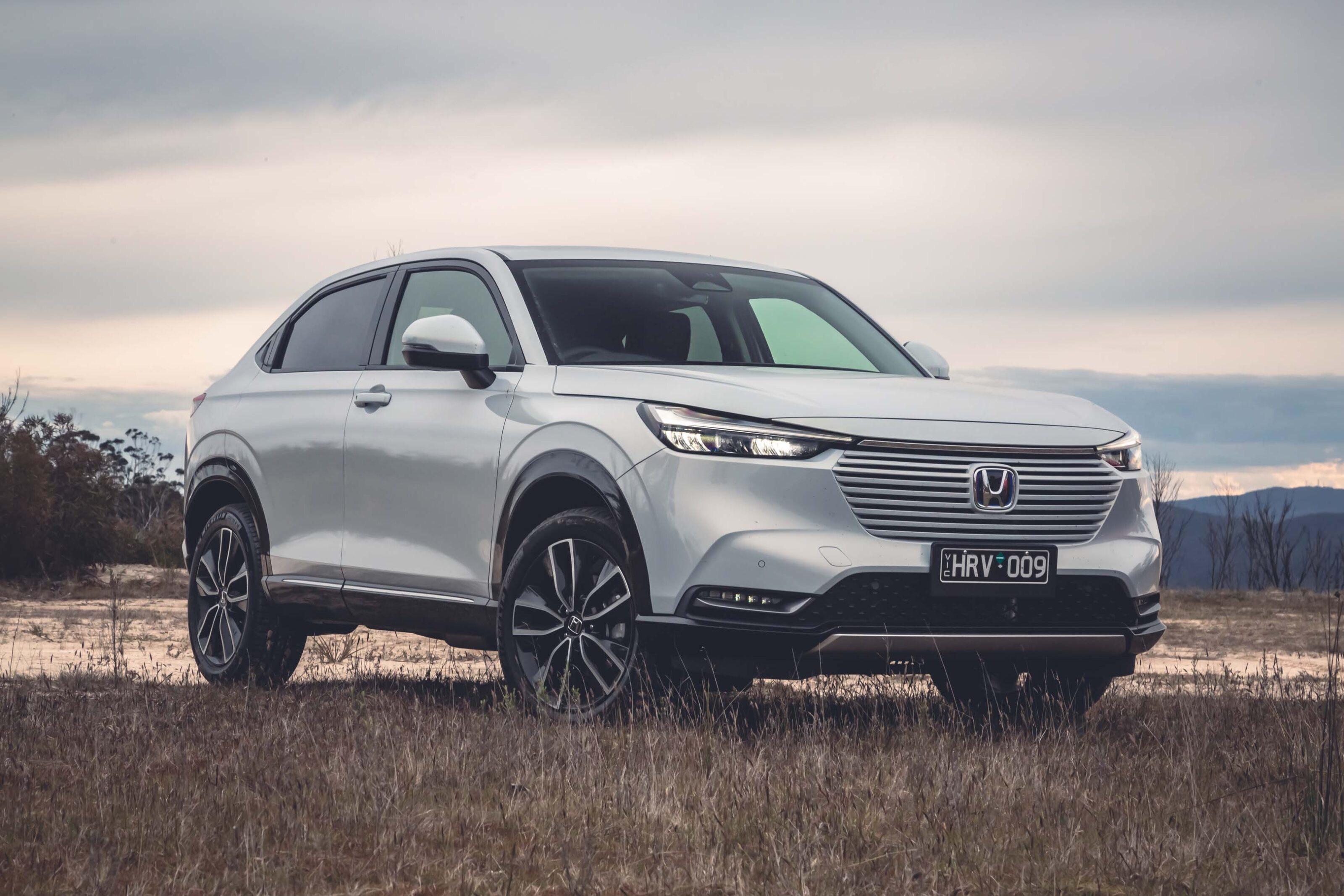
What are they like to drive?
These are both pretty good cars but the Toyota has the muscle over the HR-V. On paper there’s more power and torque and, with the extra motor at the rear, the power is going down more smoothly.
| Honda HR-V e:HEV | Toyota Corolla Cross GXL Hybrid | |
|---|---|---|
| Drive: | front-wheel | all-wheel |
| Power | 78kW @ 6400rpm | 113kW @ 6000rpm |
| Torque | 131Nm @ 3500rpm | 190Nm @ 4400-5200rpm |
| Electric motor | front-wheel | front and rear |
| Electric power and torque | 97kW/253Nm | 83kW/206Nm front, 30kW/84Nm rear |
| Combined power | 96kW | 146kW |
| Combined torque | 253Nm | not stated |
| Battery | lithium-ion | lithium-ion |
| Transmission | continuously variable automatic | continuously variable automatic |
In practice, there’s a bigger gap than I expected between the two. Where the Honda feels like it runs out of puff after about 80km/h, the Toyota keeps surging. That plays out in a warm hatch 0-100km/h time of about seven-and-a-half seconds for the Toyota.
The Toyota also has much more convincing overtaking thrust as in-gear acceleration is superior. Even four-up, the Toyota pulls fairly strongly. While Toyota refuses to give a combined torque figure, it feels like more than 300Nm.

I say that because the front motor alone contributes 83kW/206Nm to the 2.0-litre engine’s 113kW/190Nm, plus the rear electric motor’s 30kW and its own torque figure that Toyota doesn’t feel strongly about enough to list but internet consensus suggests is 84Nm.
Honda makes up for its weedier 78kW/131Nm petrol engine with a slightly beefier 97kW/253Nm electric motor but still lacks the extra thrust of the Toyota’s rear drive unit.
Both cars shuffle between electric and petrol power but the Toyota does it slightly better than the Honda while making about the same amount of racket when you plant the boot. Both handle the regenerative braking well, but unfortunately, neither really manages one-pedal operation.
As both are quite advanced hybrids, they’re quite capable of dribbling along on electricity only for a reasonable distance. You can force the Toyota into EV mode, which proved very handy during photography manoeuvring that involved some mild off-roading. It performed very well and makes you wonder how good a pure-electric Corolla Cross would be.

As both are quite advanced hybrids, they’re quite capable of dribbling along on electricity only for a reasonable distance.
The Honda was in the same boat and coped with the bumps and lumps of the photography venue but its electric-only propulsion, while pretty good, is no match for the all-wheel drive Toyota.
Out on the open road, the Toyota is slightly quieter than the Honda – around town you can barely split them – but in all conditions, the Corolla is more relaxed with its larger outputs and well-sorted suspension.
The all-wheel drive Corolla Cross comes with a little bonus of swapping the front-wheel drive version’s torsion beam rear suspension with a multi-link set-up (Toyota does the same with the smaller Yaris Cross), while the Honda makes do with torsion beams. It’s genuinely difficult to split the two, though, as the Corolla’s performance over sharp bumps doesn’t suggest the more capable rear end is present.

There was in fact an argument early in the day as to whether the Corolla had torsion beams until co-conspirator John Law and I climbed under the car for me to be proved wrong. To be fair to me, part of the confusion stemmed from a spectacular moment of laziness from Toyota.
Like most electrified vehicles, there’s an animated diagram in the media system showing you the power flow and while the central display in the instrument cluster shows the rear wheels, the main screen does not, using the same animation from the front-wheel drive car. It’s a small matter but smacks of penny-pinching.
An interesting quirk in the Corolla Cross is that the adaptive cruise control does a Rolls-Royce and reads the road ahead for any curves. When approaching a bend, the Corolla will assess its severity and back off the throttle accordingly.

That’s not going to be for everyone – it certainly wasn’t for me – but it’s a little gift of semi-autonomy that will reduce fatigue and aid folks not keen on tackling unfamiliar roads, particularly at night.
Needless to say, it’s quite a conservative system and washed a fair bit of speed off in corners I’d have been happy to continue through at the set speed.
The Corolla Cross takes a win here because it does everything well – a more sorted ride (despite the firm rear), slightly quieter cabin at speed and more capable electrification, plus the extra motor at the rear. The Corolla Cross is also slightly more fun to drive, handling big bumps and road aggro with just that little bit more polish than the Honda.
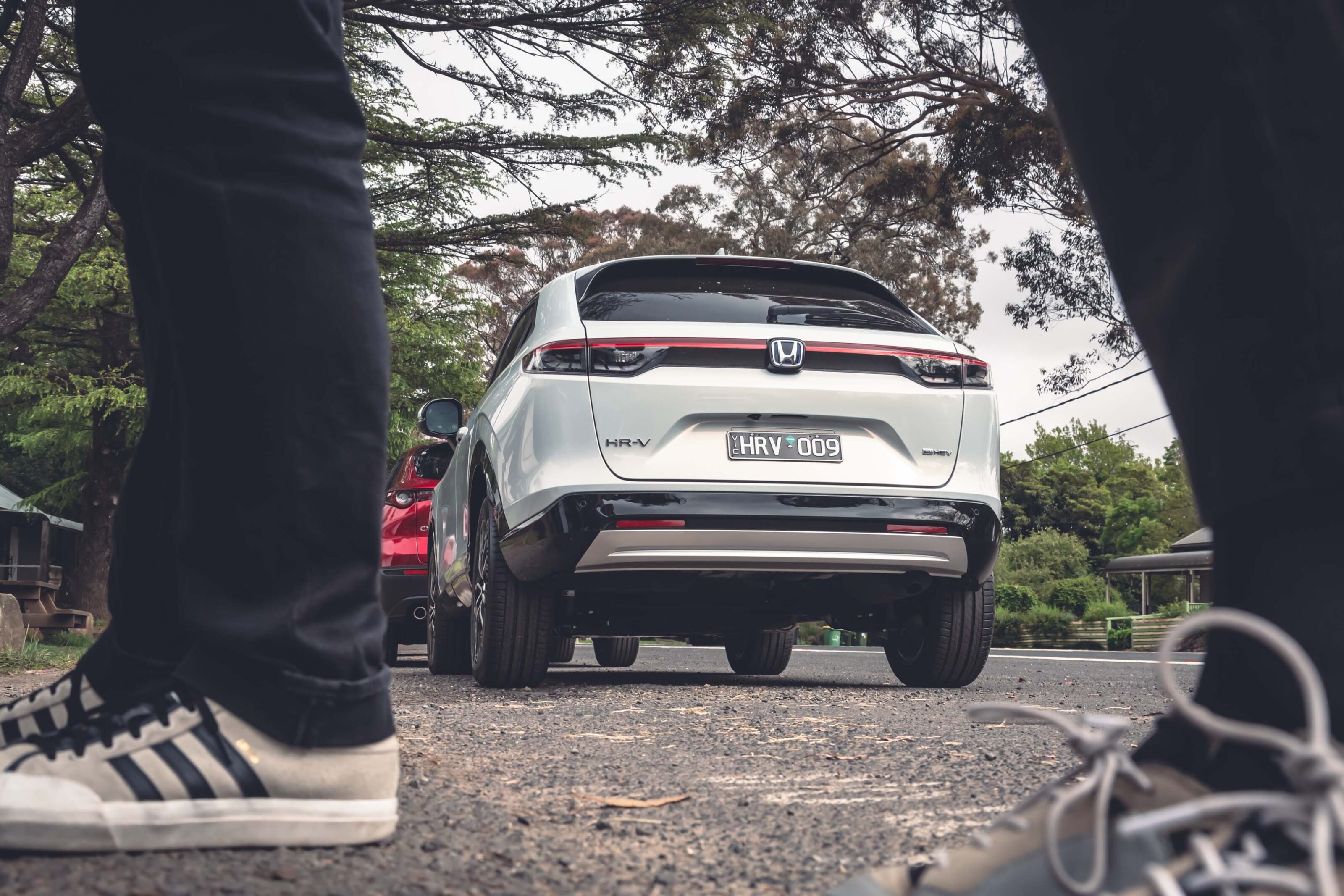
How are they on fuel?
The HR-V’s official combined cycle figure is 4.8L/100km against the Toyota’s 4.4L/100km for the AWD hybrid.
Over 373km, the trip computer on the Honda spat out a 4.5L/100km figure that was backed up at the pump. The run home from fuelling up was pretty much half motorway and half traffic and the trip computer – which as you can see appears to be trustworthy – read 4.3L/100km. That’s an excellent achievement.
The Corolla Cross got quite a workout in the week it spent with the Wheels team, participating in this twin test, a four-way test and in the hands of m’colleague John Law. In urban running similar to the HR-V’s it managed 5.0L/100km and ran as low as 4.3L/100km on the long, demanding test loop.
So we’ve got a draw here – they’re both great on fuel, but it’s worth remembering that the Honda has two fewer driven wheels and delivers a lot less power and torque. One of the reasons the Corolla can get so close is that the rear wheels are only ever driven by the electric motor, meaning there is no direct drive from the engine and gearbox.
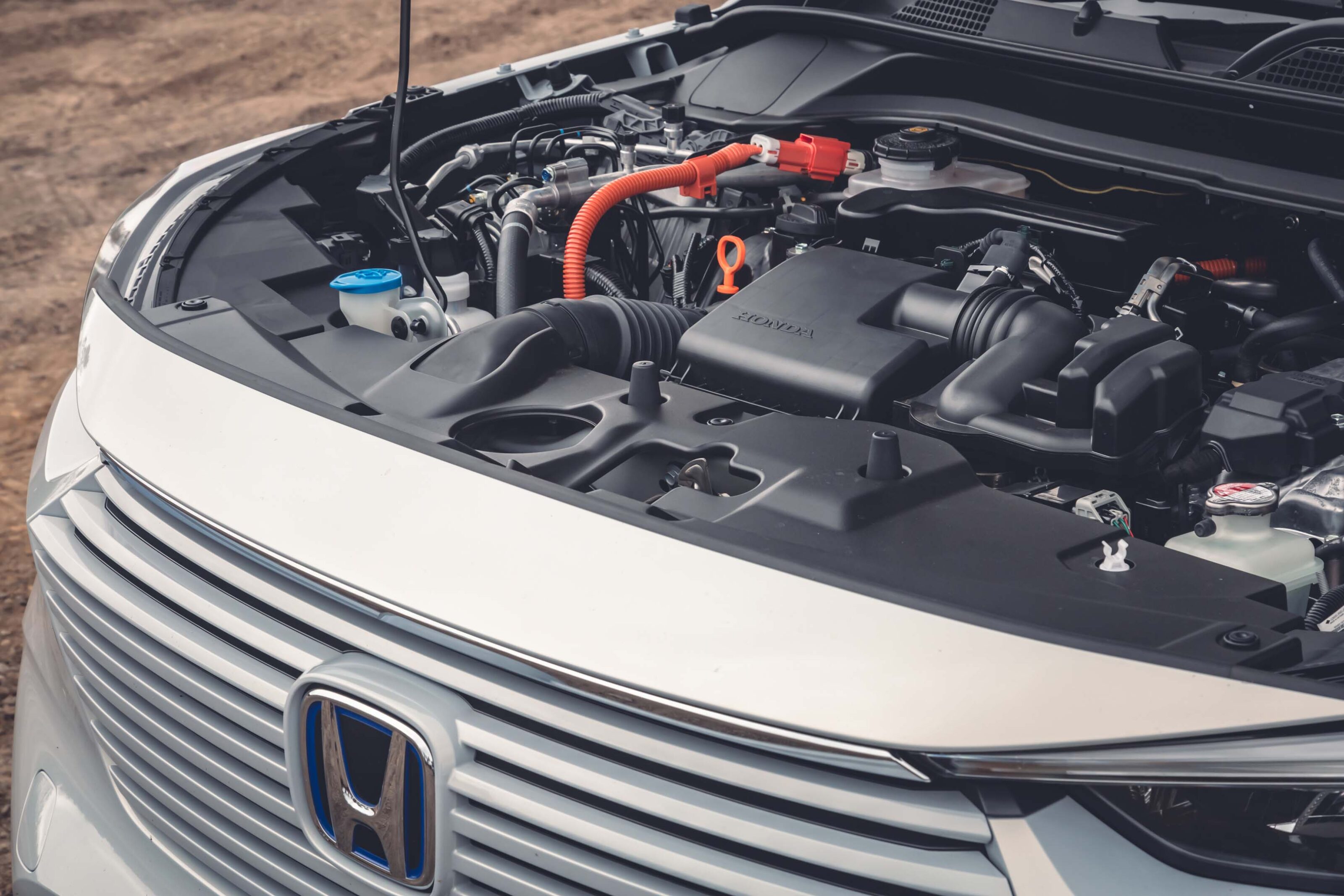
How safe are they?
Neither car has an ANCAP safety rating as of October 2022.
The clear differences between them are the extra two airbags in the Corolla Cross, one of which is a front centre airbag to stop head clashes in a side impact.
The Toyota’s forward auto emergency braking (AEB) also features front cross-traffic alert with braking (to stop you turning across oncoming traffic) and parking brake assist (stops you bumping stuff while parking), which is kind of a low-speed reversing AEB.
One would expect the eventual ANCAP crash will result in a five-star rating for the Corolla Cross (given the presence of the front centre airbag) while Honda’s four-star EuroNCAP score will most likely be reflected locally.
But, as ever, you can’t tell until the statutory body sings. It remains a curiosity to me that ANCAP hasn’t taken the Euro score as does with many other cars.
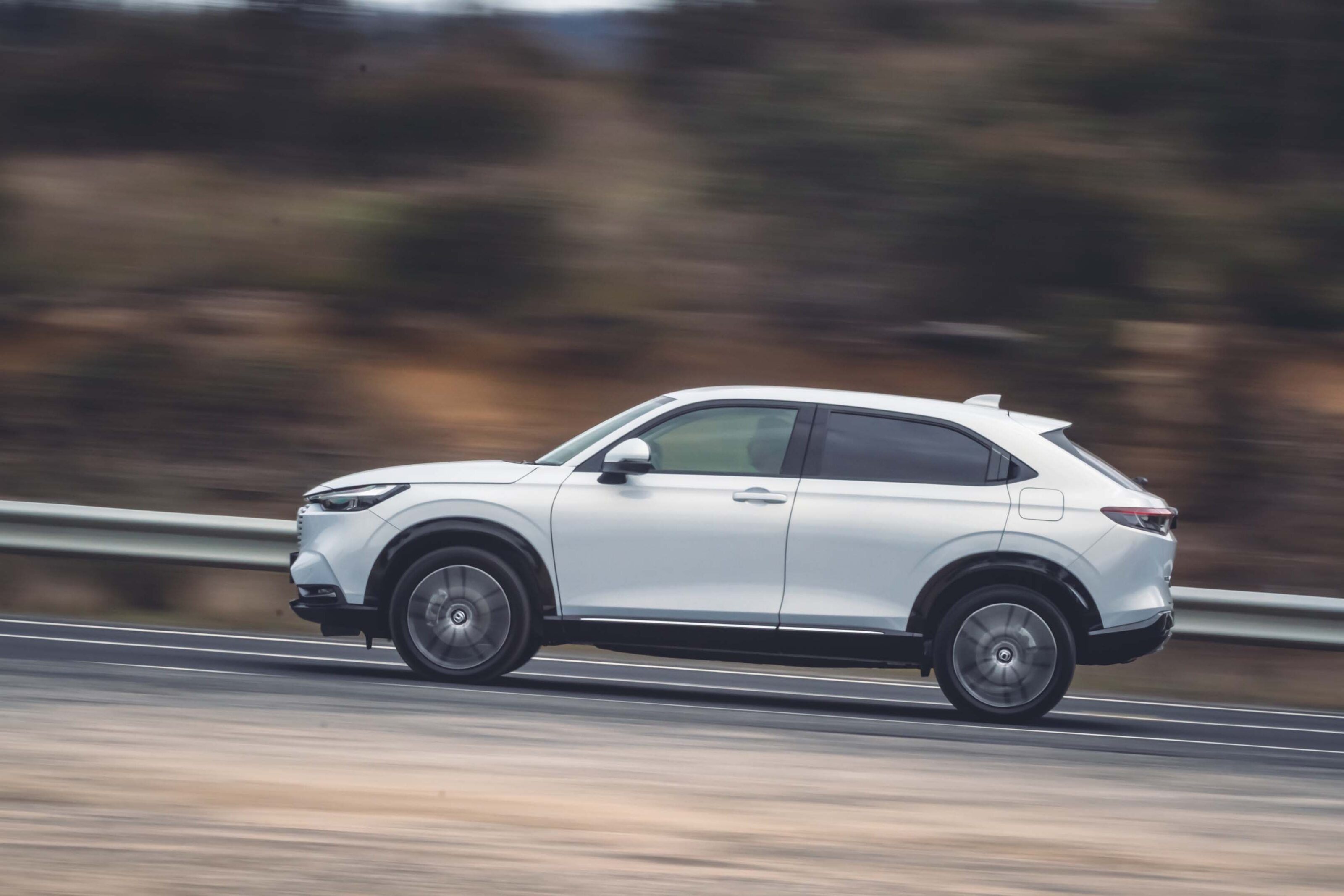
| Honda HR-V e:HEV | Toyota Corolla Cross GXL Hybrid |
|---|---|
| 6 airbags | 8 airbags |
| ABS | ABS |
| Stability and traction controls | Stability and traction controls |
| Forward AEB (low speed) | Forward AEB |
| Reverse cross-traffic alert | Reverse cross-traffic alert |
| Lane departure warning | Lane departure warning |
| Lane-keep assist | Lane-keep assist |
| Forward collision warning | Forward collision warning |
| Road sign recognition | Front cross-traffic alert with AEB |
| Pedestrian alert | Parking support brake |
| Blind-spot monitoring | Blind-spot monitoring |
| Reversing camera | Reversing camera |
The Honda has just two top-tether child seat anchors (hence being restricted to four-seat status) but we all know the reality of this is that it would extremely difficult to run three child seats across that back row. The Corolla Cross has three top-tether anchors and both cars feature two sets of ISOFIX points.
It is another win here for Toyota, with the extra safety gear that will make a genuine difference both to avoid accidents and if you’re in one.
Warranty and running costs
Both cars offer a five-year, unlimited-kilometre warranty and a five-year capped-price servicing regime.
The Honda will cost $625 for the first five services while the Toyota will ask $1150.
Now. The Honda is cheaper because the service intervals are 12 months/10,000km, that latter figure below the average annual usage of a car in Australia. If you reckon you’ll stay under 10,000km per year, you’re saving $100 a year on servicing.
The Toyota stretches closer to the average at 12 months/15,000km and works out at $230 per year for servicing. So another draw.

VERDICT
The Toyota takes the win here for a few, small reasons.
It is the better car to drive and with the extra driven wheels and more convincing hybrid system, it combines swift performance with frugality. The Honda isn’t a slouch but it runs out of power and therefore, in this company, feels underdone.
While the Honda has the better-looking car inside and, for me at least, out, the Toyota’s advantages outweigh the subjectives as well as bringing more safety gear to the table, an important consideration in a family car.
The Corolla could – and should – have a better interior with fewer blanks, but it will tackle pretty much anything you throw at it without breaking a sweat. The Honda just won’t quite match it once you leave the city. A small victory, then, and a smaller one than I was expecting.

SCORING
| Honda HR-V e:HEV | Toyota Corolla Cross Hybrid GXL AWD | |
|---|---|---|
| Safety, value and features | 7.5 | 8 |
| Comfort and space | 8.5 | 8 |
| Engine and gearbox | 7.5 | 8.5 |
| Ride and handling | 7 | 8 |
| Technology | 7.5 | 8 |
| OVERALL | 7.5 | 8 |
Toyota Corolla Cross GXL: 8/10
What we like
- Strong engine and drivetrain
- Good fuel economy
- Good servicing program
- Strong safety package
Not so much
- Blank buttons in the interior
- Limited rear legroom
- Some cheap materials
Honda HR-V e:HEV: 7.5/10
What we like
- Mature design inside and out
- Clever interior
- Great fuel economy
Not so much
- Missing some safety gear
- e:HEV runs out puff
- Only four seats
2022 Toyota Corolla Cross and Honda HR-V specifications
| Honda HR-V e:HEV | Toyota Corolla Cross GXL Hybrid | |
|---|---|---|
| Body: | 5-door, 4-seat small SUV | 5-door, 5-seat small SUV |
| Drive: | front-wheel | all-wheel |
| Electric motor | front | front and rear |
| Power | 78kW @ 6400rpm | 113kW @ 6000rpm |
| Torque | 131Nm @ 3500rpm | 190Nm @ 4400-5200rpm |
| Electric power and torque | 97kW/253Nm | 83kW/206Nm front / 30kW/84Nm rear |
| Combined power | 96kW | 146kW |
| Combined torque | 253Nm | not stated |
| Battery | lithium-ion | lithium-ion |
| Transmission | continuously variable automatic | continuously variable automatic |
| 0-100km/h: | 10 seconds (estimated) | 7.5 seconds (claimed) |
| Fuel consumption: | 4.3L/100km (tested) | 4.4L/100km (tested) |
| Weight: | 1382kg | 1545kg |
| Suspension: | MacPherson struts front/torsion beam rear | MacPherson struts front/trailing arms rear |
| L/W/H: | 4335mm/1790mm/1590mm | 4460/1825/1620 |
| Wheelbase: | 2610mm | 2640mm |
| Brakes: | not stated | 305mm ventilated discs front, 281m solid discs rear |
| Tyres: | 225/50/R18 Michelin Primacy | 215/60 R17 Bridgestone Alenza |
| Wheels: | 18-inch alloy (no spare) | 17-inch alloy (space-saver spare) |
| Price: | $47,000 drive-away | $42,250 + on-road costs |
Things we like
- Corolla Cross: Strong engine & drivetrain, good on fuel, good servicing deal, strong safety
- HR-V: Mature design in and out, clever interior, great on fuel
Not so much
- Corolla Cross: limited rear legroom, blanking buttons inside, some cheap materials
- HR-V: Missing some safety kit, e:HEV runs out of puff, only four seats
We recommend
-
 News
News2022 Honda HR-V pricing and features: Hybrid joins Australian line-up
Honda’s all-new HR-V has arrived with more features, fewer seats, and new engine options
-
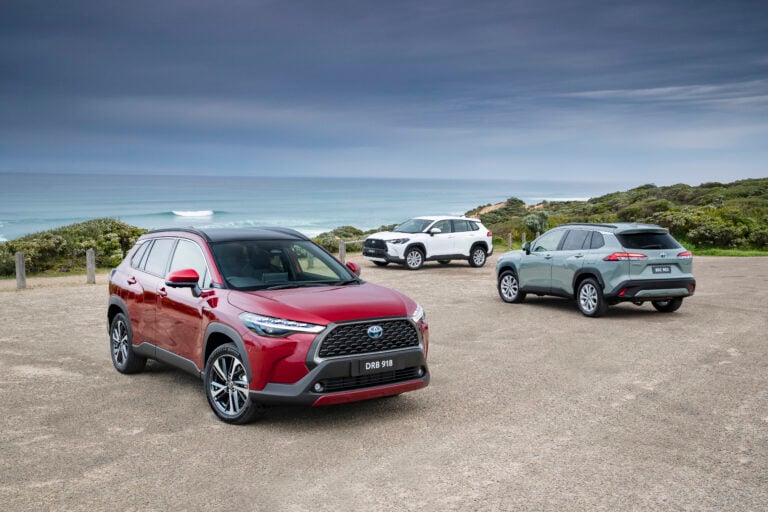 News
News2023 Toyota Corolla Cross pricing and features
Toyota's new small SUV, the Corolla Cross, has landed in Australia, slotting between the Yaris Cross and RAV4
-
 News
NewsNew car calendar 2026: All the new cars coming to Australia next year
Here’s the WhichCar by Wheels guide to all the new cars that will launch in Australia in 2026. Check back in regularly for updates...




